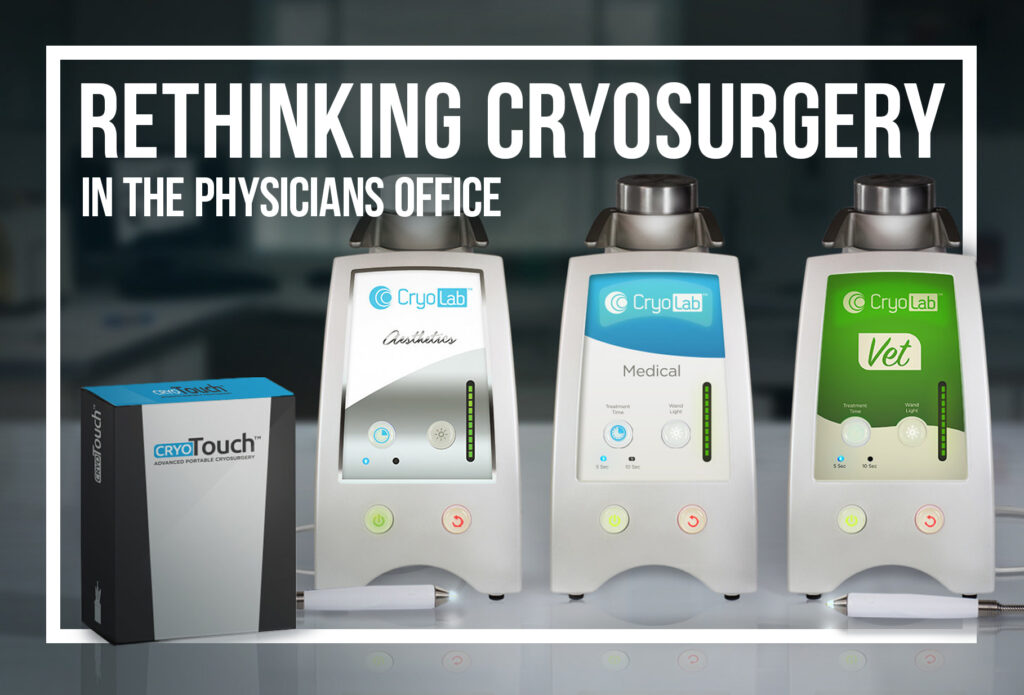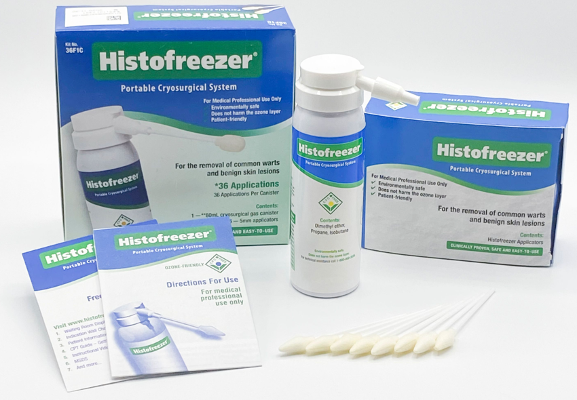Blog
Rethinking Cryosurgery in the Physicians Office
Cones, Buds and Environmentally-Friendly Next-gen cryo devices will deliver better results, reduce medical waste, and generate higher profits
It is hard to believe that 30 years have gone by since the introduction of canister-based devices for cryosurgery. These highly portable products had a big impact making cryosurgery available across many specialties including pediatrics and family medicine.
Three decades ago, professional brands such asHistofreezer® (shown below) were introduced as an alternative to liquid nitrogen and treated a wide range of common benign topical lesions, minimized trama to healthy tissue, and lowered the upfront investment costs of using cryosurgery. The impact of the portable forms of cryosurgery on the physician’s office market was indeed significant. It is estimated that over 500 million lesions have been treated by canister-based cryo devices which underscores the success of portable cryosurgery.
Innovation & Cryosurgery – What’s Next?
So, the question is, what’s next for portable cryosurgery? Are there new advances on the horizon to improve outcomes? Are there new gases available that are more efficient and better for the environment, and will new product designs make cryosurgery more user and patient friendly?
In this article, you will learn about exciting advances in cryosurgery that make it easier to use, increase the first-time success rate, dramatically minimize medical waste, and increase profits for the practice.
Killin’ It By Chillin’ It – Fast Freezing of the Treatment Site is Critical for Best Results
Cryosurgery works by destroying target tissue through application of extreme cold. The application of the extreme cold is accomplished with a Bud, Cone or open spray1. The process is simple but there are steps to assure optimal outcomes. Numerous peer reviewed studies have shown that cryosurgery works best when the temperature is sufficient to kill the target cells, freeze/thaw cycles are used and these cycles employ a rapid freeze and a slow thaw2,3,4.
For canister based products using a Bud this is difficult because they also require a long wait time (15 or more seconds) for the bud to reach its effective freezing temperature (less than -50oC). Traditional open Cones on the other hand allow direct application of the gas however the gas splatters when sprayed and rapidly evaporates requiring multiples fills of the cone.
To address these issues, new devices such as Histofreezer® FLEX from CryoConcepts, LP, uses a new mixture of two cryogens (Difluoromethne and Pentafloroethane) that immediately reach at least -52oC. To help maintain and comfortably deliver the extreme cold gas, CryoConcepts totally redesigned the kits buds and cones. The result was an easy to use one handed operation that is an extremely efficient and effective method to deliver the cryogen gas using a cone or bud. The chart below shows how much more efficient the Histofreezer® FLEX is at using gas versus a devices that uses open cones. Histofreezer flex uses about 1/5 the amount of gas of traditional cones which translates to more uses per kit!!
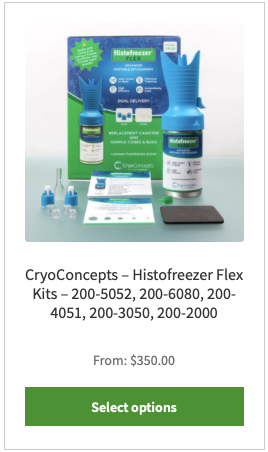
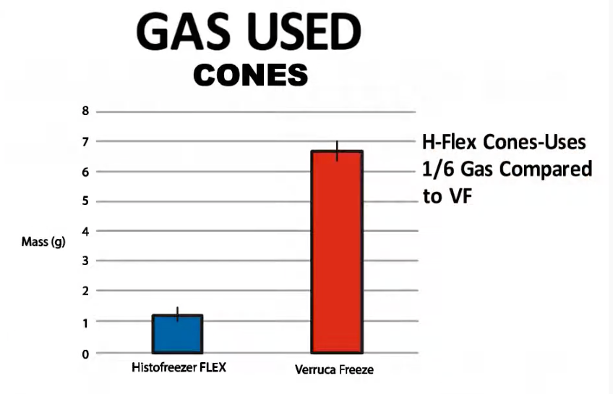
Source: FDA Submission Data
Another benefit of the cryogen gases found in Histofreezer® FLEX is that they are non-flammable, have no effect on the Ozone, and have one half of the global warming potential versus other older canister devices on the market.
Histofreezer® FLEX – Rethinking the design of cones or buds
Historically, cryo canister devices fall into two primary delivery categories 1. open cones and 2. buds. Research has found the physicians preference for using buds or cones is about 50:50 and the standard design of cones or buds has remained unchanged for over three decades. Open cones work exactly as described. A funnel-cone is placed over the lesion and a spray of gas fills the cone. The problem is the gas splatters on clinician and patient and rapidly evaporates requiring refill. Buds, as an alternative, are made of foam that is filled with cryogen gas that must first evaporate to reach effective temperatures. Physicians lived with these limitations, but our team took the challenge to rethink and remove the historical issues when using an open cone or foam bud.
“Our goal from the very beginning was to design a devices that could work equally as well with both buds or cones,” said Dr. Sam Niedbala, CEO of CryoConcepts, LP. “We redesigned the buds to improve their ability to be immediately ready to use and stay cold longer. Our closed cone design eliminates any cryogen splatter and uses less gas as compared to open cones. We have dramatically improved the delivery of cryogen gas to the treatment site minimizing the amount needed to freeze the target lesion. Lastly, we wanted to make portable cryosurgery easier to use and made Histofreezer FLEX so it operated with just one hand.” he added.
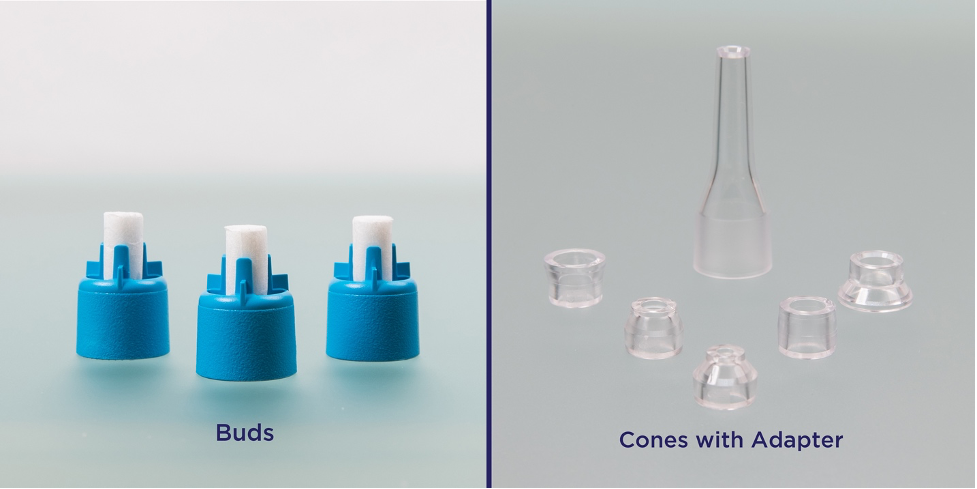
Setting the Standard for Less Medical Waste
During development, interviews with physicians revealed a high sensitivity to the issue of reducing medical waste. In fact, some report a “feeling of guilt” over the amount of waste they produce and are actively looking for products that can reduce their “environmental burden”. A good start, in this case, is putting an end to the tens of thousands of empty cryogen canisters that end up in landfills every year.
So, the goal of minimizing waste was a key design challenge for the engineers at CryoConcepts during the product development process for Histofreezer® FLEX. They identified a new canister that can be returned to the CryoConcepts that can be refilled, and reused by physicians – a first in the cryosurgery market.
“Our commitment to be good stewards of the environment runs deep at Cryoconcepts. We have the first reusable canister in our industry and we encourage our customers by including a pre-paid address label in every kit to make returning the empty canisters as seamless as can be,” explained Dr. Niedbala.
Better Outcomes. Better Design. Better for the Environment
Medical devices makers can have challenging goals when it comes to new product development. Medical professionals require new devices that deliver better results, at lower costs while being easy to use. In addition to clinical outcomes, new products must be better for the environment and reduce medical waste.
So, it is no surprise that innovation in cryosurgery has taken almost 30 years to achieve. The good news is that CryoConcepts has answered the call and has delivered meaningful innovation to the portable cryosurgical category.
Resources
www.cryoconcepts.com
https://youtu.be/qsnba5p_gfc
References
- Usatine R, Stulberg DL, Colver GB, Cutaneous Cryosurgery, 4th ed, CRC Press, 2015
- Andrews, Mark, Cryosurgery for Common Skin Conditions, American Family Physician, 69:10, 2365-2372, 2004.
- Gage AA, Baust J, Mechanisms of Tissue Injury in Cryosurgery. Cryobiology, 37, 171-186, 1998
- Thai KE, Sinclair RD, Cryosurgery of benign skin lesions, Australasian Journal of Dermatology 40, 175–186, 1999

